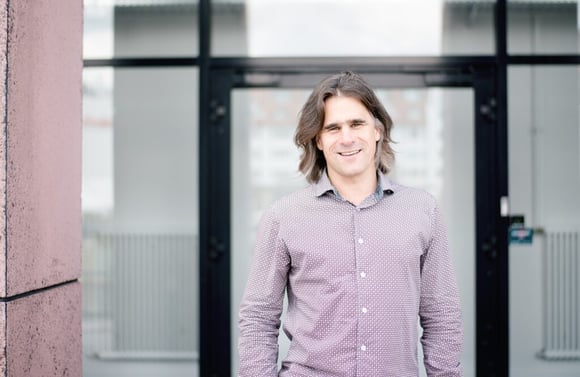The Device Chronicle interviewed Juergen Boss, Head of Product Management, HELLA Aglaia Mobile Vision GmbH on people and occupancy sensing in the transport industry and how digitalization is evolving services.
Juergen is trained as a mechanical engineer and business administration and came to Hella Aglaia to lead product management of its market-leading people and occupancy sensing solutions three years ago. HELLA Aglaia’s customers in transport include system integrators focusing on refurbishment projects; OEMs such as Siemens and Bombardier, and the rail and bus operators themselves.

HELLA Aglaia is a subsidiary of Hella Group – which is also a market leader in automotive components: known for car headlights, and now advancing with new innovations in in-car interior illumination, , driver assistance for lane keeping and maintaining distance between cars, with AI expertise such as the segmentation of camera images to detect pedestrians in the track, as the automotive market moves through the levels to fully autonomous driving.
Important innovation in occupancy sensing
HELLA Aglaia has had, and is still having a tremendous impact on the train and bus industry with the innovative introduction of people counting with high precision – with over 99% accuracy. Today, counting or “people and occupancy sensing” is a very important task and it is challenging to perform it accurately. Business models and revenue sharing agreements between stakeholders in the industry depend on this high degree of accuracy. Juergen notes that “the most important use case for counting at the door is underlying and impartial analysis as a basis for revenue sharing models between stakeholders. Juergen explains “If you have a public transit agency that oversees a large rural area with several operators, then they need a mechanism to allocate how the revenue and commissions are shared based on passenger volume and mileage contributed by each respective operator along the routes.”
A shift in demand to occupancy sensing
Juergen and his colleagues at HELLA Aglaia have observed a paradigm shift in the transport market from counting at the door to knowing more about how passengers behave within the vehicle in almost real time. Yet the transport sector moves slowly, and partially, Juergen believes that this is down to mindset due to the long heritage. He says “Rolling stock is extremely expensive. Once a train is put on the track it must operate for three decades, and you don’t want to change components on a regular basis. There is also an imperative to minimise downtime for maintenance and upgrades, as this can be extremely expensive. The railway industry expects to put equipment into service that doesn’t change for years or decades. There are strict regulatory requirements around safety and this can make the business slow and cumbersome, it is not an industry that is agile by design. For example, there is a reuse of older but still functioning equipment for “people counting” that is taken from one bus and remounted on another so that things last for longer.”
Digital brings change
Juergen also sees that this cautious attitude is changing with the advent of digital transformation. He says “The transport industry needs more updated functionality. It needs more up-to-date information faster.” In light of this change, in addition to being a component supplier, HELLA Aglaia is enlarging its scope to be able to cater for the digital evolution. “In addition to supplying the devices, we are striving to optionally hook the devices to our IoT platform as an enabler. With the effect that the user can see, maintain and update devices without a need for downtime, maintenance and recertification for use.”
Emerging use cases involving AI
Today, Juergen and the product group are looking inside the vehicle. He continues “so that we have load and occupancy that can be detected and transmitted in real time as operators are looking to guide passengers to the most convenient connection. The service goal is to use insights from the data to guide passengers to the most comfortable connection. Operators want to provide passengers with information on how comfortable the ride will be. Some travel options might be faster, others might be more comfortable as the passenger would get a seat and real time data on occupancy is required to guide this. The HELLA Aglaia product team uses AI sitting on CCTV camera streams and for counting. And then there is a merge between the CCTV and the counting domain – detect violence, vandalism, identification of dangerous objects such as a forgotten suitcase left in a carriage. These tasks are beginning to converge between vision and counting. The idea is to form a physical installation that can address all these tasks.
Edge analysis and respecting privacy
Respect for data privacy is a paramount concern for Juergen and his colleagues at HELLA Aglaia. To ensure that privacy regulations are adhered to, analysis within the sensor is done on the edge. “It doesn’t record video or private information, it just counts or detects occupancy levels. It passes data privacy requirements, we process image streams but we do not record images and there is no explicit identification of people.” In public transportation Juergen and his group are required to use recorded videos of passenger actions to train our AI models. These passenger actions have to be simulated to train the neural networks. Video footage from real life scenes cannot be used. Robust real lift systems need constant retraining. Juregen and his team perform conventional computer vision and image processing on the stereo counter today. They also perform occupancy detection with machine learning, and as part of the HELLA Group, there exists a strong competence to interpret images with AI.
But Juergen admits that there are still some areas where data privacy has tension with the need to use innovation to address a use case. For instance, Juergen points to remote maintenance where a user will need a live video stream and this creates a dilemma for privacy and this is still to be solved.
Role of OTA software updates
OTA software updates is a key to success as Jurgen believes that it can give a product organisation a good grip on their devices fleet, allowing them to take operating service in their hands, and optimise the performance of tasks where once the system integrators would be responsible for this. “Operators are starting to understand the benefits of a more open and less confined system.”
Most updates today are security updates for the latest Linux kernels, bug fixes, and for supporting quarterly software releases. OTA updates also support feature extensibility. Examples of features that are added after the sensor hardware has been shipped include occupancy rating of the area that the counter oversees, identifying if a wheelchair is in the wheelchair area? Juergen says “Some of these new features can be charged for as part of the business model so it is interesting to have sensors on your IoT platform.”
Also, Juergen cautions that in the rail industry, providers have to be careful that the complete functionality of what is built inside a train is subject to certification. “You cannot just have an open line to home base and perform a software update without telling anybody.”
In the end, for Juergen, secure and robust OTA software updates address the challenge of ensuring that the integrity of the complete system of sensors distributed across the country in dozens of trains and hundreds of carriages is on the same firmware version so that we can ensure that the counting results can be compared. It also gives assurance that all devices have been updated at a particular point in time and being able to access the devices at all is a big challenge due to connection challenges. Finally, being able to roll back to a previous version and prevent bricking of devices.
We wish Juergen and his colleagues well as they continue to optimise the precision and accuracy of people sensing and occupancy in the transport industry and other sectors such as retail.
